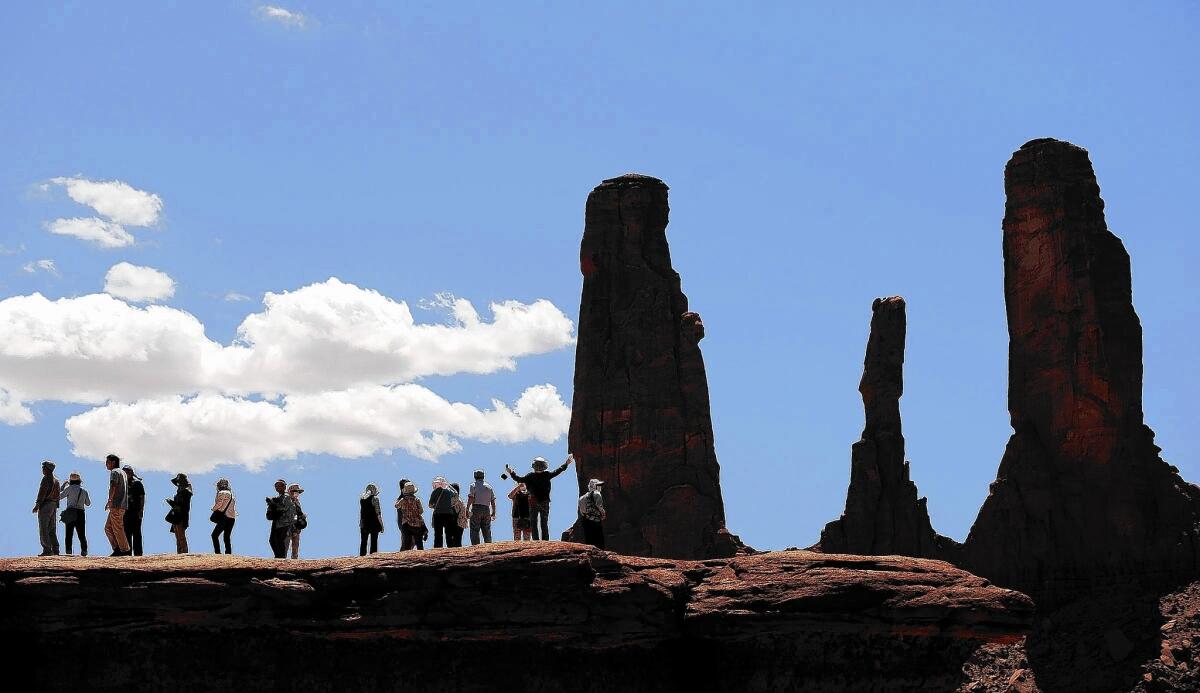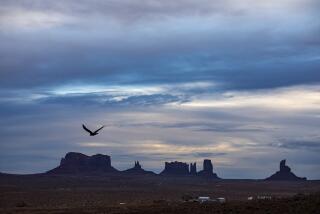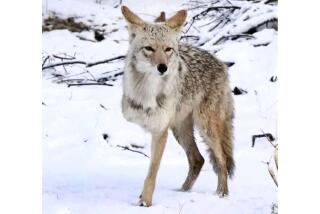Trying to share Monument Valley without ruining it

Harold Simpson lets loose a high-pitched wail that breaks the desert silence, an emotional unleashing that harks back to his colorful past here:
“Hooooo-whoooooo!”
The whoop echoes off Rain God Mesa and two other red-rock behemoths that jut purposefully from the land. For Simpson, they’re backdrops to a wild-at-heart boyhood in this Navajo-owned tribal park — a place that’s at once an international tourist destination and a Native American park laden with spiritual significance.
His cry reverberates into the distance. Then the quiet returns.
“That’s the call my grandmother made to let us know the food was ready, that it was time to come home,” he says softly. “I can hear her calling now.”
Simpson appreciates the quiet of this place but also sees in its beauty opportunity.
Simpson, 47, owner of a Navajo tour company, stands in the center of an internecine tribal development controversy within a park whose timeless 1,000-foot-tall monoliths have become a symbol of the untamed West.
The Monument Valley Navajo Tribal Park has served as the backdrop for John Ford westerns such as “The Searchers,” starring John Wayne; the culmination of Forrest Gump’s exhaustive run; and music videos by Madonna and Michael Jackson.
Navajo elders believe the remote 130-square-mile spread on the Arizona-Utah border is being exploited for tourism: They criticize a new Navajo-owned hotel and adjacent RV park, as well as plans by the tribal park service to grade a treacherous stretch of a 17-mile rutted dirt road leading here that now keeps most cars at bay.
They point to wild juniper and blue sage choked off by vehicle dust. Visitors have stolen pottery from historic sites and scarred ancient rock petroglyphs with “Bob was here” graffiti.
“We can’t watch people every second,” said Stanley Crank, a tribal park supervisor. “It filters down to a respect and deep sense of reverence for the land. We’re trying to teach that.”
Native American tribes nationwide face similar growing pains as they promote tourism on sovereign lands.
“They’re realizing the need for balance to keep people in place and traditions alive,” said Camille Ferguson, director of the American Indian Alaska Native Tourism Assn. “It’s knowing what the land can handle, perpetuating culture and not just raking in money.”
Simpson understands why elders believe the area they call “The Talking Rocks” should remain untouched, that growth could leave his childhood home overrun with tourist shops, like in Sedona, Ariz.
Last year, 365,000 visitors paid the $20-per-vehicle fee to ruminate among the formations here — compared with the nearly 5 million who flocked to the Grand Canyon. That kind of exposure, everyone agrees, would kill this place.
“You want to share this place,” he says. “But where do you draw the line?”
Simpson suggests there’s a middle way. He says the tourist invasion provides a livelihood for two dozen Navajo-run tour companies. He wants to see the road graded but says the park should allow fewer private cars and require visitors to ride in tourist buses to cut down on traffic.
He runs Simpson’s Trailhandler Tours, which brings thousands of mostly foreign visitors into the park on guided cultural expeditions. On each, he explains how one relative, whom he calls “Mr. Gray Whiskers,” helped designate the tribal park in 1958.
Carrying visitors on open-air buses, he calls the ethereal formations by their simple Navajo names, such as “Ear of the Wind” and “Many Rocks Standing Together.”
Simpson was raised by his grandparents, who ran sheep, cattle and goats on a spread without electricity or running water. Home was a hogan, a rounded structure made of logs plastered with adobe.
When his mother went off to work at a local drive-in, he and his brothers and cousins explored the exotic land around them. “I know it was every boy’s fantasy, but we just knew it as our backyard,” he said. “We were out in the wilderness, climbing rocks, herding sheep, running cattle.”
Years later, after college, Simpson moved to Europe, living for more than a decade in Sweden and the Netherlands. As an albino with blue eyes and blond hair, he blended in easily, and as years passed, drifted from his culture. But he also saw how foreigners revered Native American spirituality.
He listened as Dutch travelers waxed about a magical Navajo park in the heart of the U.S. desert — his desert.
In 1996, he decided to return and tell the tale of Monument Valley through Navajo music, food, ceremonies and language. When his grandfather first spoke to him in Navajo, he struggled to form responses. He’d been gone too long.
Now he introduces visitors to the mystical shapes of his boyhood; the formations that to him looked like sleeping dragons, bears, penguins and surfacing submarines. He explains how this place existed long before John Wayne and Forrest Gump.
Visitors bring their tourist dollars, but also a fair amount of ignorance and insensitivity.
Linda Jackson Rodriguez, who sells jewelry here, describes the daily insults she endures from tourists who see Native Americans as props in an old cowboys-and-Indians flick. She picks up strewn trash and feels that her temple has been violated.
“People ask if I can leave the reservation,” she says. “One man asked, ‘So when do you people mate?’ I said, ‘We do it just like you do.’”
Simpson also feels the sting. Many tourists see him as a cartoon — do you sleep in a tepee? — or ask how many wives he has. His skin has thickened. To the question of how a blue-eyed blond could be Navajo, he quips, “I’m the white sheep of the family.”
But when the tourists leave for the day, the park becomes that magical desert the Dutch travelers described to him years ago. On this day, the afternoon shadows creep across the landscape. Simpson sits on a rock inside the Sun’s Eye, a towering cavern with a ceiling hole that reveals the sky.
Nesting ravens caw as he plays a wooden flute and chants at a spot he discovered as a child. Then he pauses to listen to the wind, just like he’s always done here.
After a few moments, he speaks. “Now we’re back to the quietness.”
More to Read
Start your day right
Sign up for Essential California for news, features and recommendations from the L.A. Times and beyond in your inbox six days a week.
You may occasionally receive promotional content from the Los Angeles Times.







